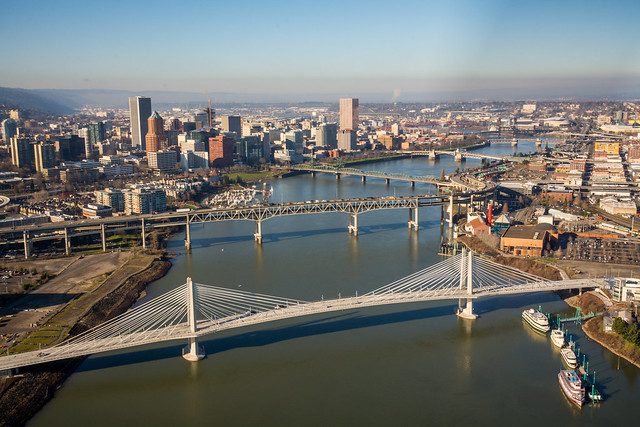
(Photo: TriMet)
Four years after the Portland area’s transit agency furiously chopped costs and recruited other local governments to balance the budget for its new $1.5 billion rail line, the price tag so far is turning out to be more like $1.3 billion.
Though a few remaining bills have yet to be paid, the combination of far more cost-efficient track and systems construction than expected and persistently low interest rates has been so large that TriMet has been searching for new ways to spend some of the unexpected surplus locally.
Last summer, as the scale of the surplus became clear, TriMet recruited U.S. Sen. Jeff Merkley to ask the Federal Transit Administration for permission to restore $38 million worth of projects that were eliminated during TriMet’s round of last-minute cost cuts in September 2010, most notably $25 million in additional free parking garage spaces at the new Tacoma and Park Avenue stations and $9 million for two additional new light rail vehicles.
In a letter dated March 6, the relevant FTA administrator agreed to three smaller changes totaling $3.6 million but denied the larger requests.
“Completing the project under budget is a substantial accomplishment and TriMet will retain the local share of the cost savings and can apply those funds toward these activities,” FTA Regional Administrator Richard Krochalis added.
In an email Tuesday, TriMet spokeswoman Mary Fetsch (who provided BikePortland with the documents linked from this post via a series of public record requests) echoed Krochalis.
“Having such a complex project come in on schedule and under budget is a testament to the quality of the team, our partners, our contractors, our subcontractors and our trades and apprentices,” Fetsch wrote. “All of our six MAX construction projects have been delivered on time and on budget; you may recall that the MAX Yellow Line opened four months early and under budget.”
At least $34 million to spare within current scope of project
According to a December 2014 construction report, downward revisions of $64 million from “guideway and track elements,” $42 million from “systems,” $33 million from finance charges and $70 million in unallocated contingency had left the agency with exactly $199,955,869 in “uncommitted” dollars from its $1.5 billion budget.
Thanks to the scale of savings, the transit agency now faces a pleasant dilemma: With at least $34 million, and maybe much more, still to spare in its budget, are there any other capital investments to be found that would (unlike the additional parking garages) be within the scope of the FTA-approved plans?
Even if the agency chooses to give up on the rest of its 50 percent federal match, accept the FTA’s congratulations and return tens of millions to the beleaguered federal transportation budget in 2019, it may still have millions in local funds to spend on capital projects anywhere in the region.
In an interview last week, Fetsch said TriMet hadn’t yet decided on its next move.
How much money is $34 million?
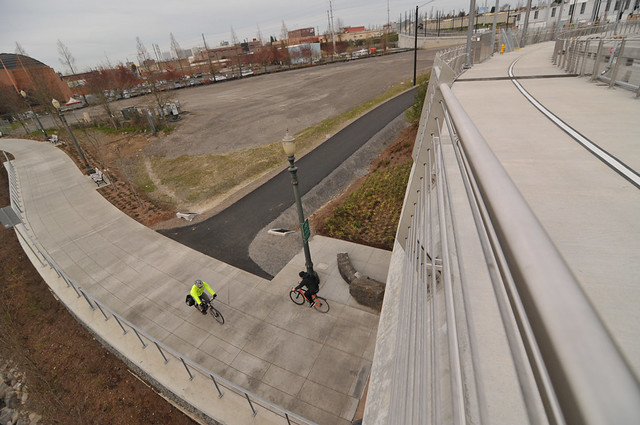
(Photo: J.Maus/BikePortland)
Though it’s less than 3 percent of the cost of the new 7.3 mile rail line and related road work, $34 million is a vast sum in the world of biking and walking infrastructure.
“At that price we could get bike sharing stations at every single Trimet station,” Bicycle Transportation Alliance Executive Director Rob Sadowsky said. “We could get five downtown protected bike lane projects.”
“We could spend $500,000 on traffic calming at the each of the top 60 most dangerous intersections in the Portland Metro region,” said Noel Mickleberry, Sadowsky’s counterpart at Oregon Walks. “That’s 425 high-end signalized crosswalks. I don’t know what the cost would look like, but I wonder what safety improvements along one entire high-crash corridor, like Powell, would look like.”
In 2008, Portland Bicycle Coordinator Roger Geller estimated that the entire citywide biking network to date had cost $60 million to install.
Advertisement
None of those items is within the scope of TriMet’s FTA grant application, so TriMet couldn’t receive its 50 percent federal match for them. Nor could the money be spent to improve bus or rail frequencies, because the local bonds TriMet issued for the project can only be spent on capital projects — infrastructure and vehicles, essentially.
But the examples do communicate the scale of federal capital grants available for transit, and also the amount of money that could theoretically be available for late-breaking design tweaks to Orange Line-related rail and bus stations or to the $65 million already spent on new biking and walking infrastructure.
Connections to transit still leave plenty of room for improvement
Though TriMet’s investment in biking and walking routes to connect to its new bridge and transit stations has been substantial (more on that in a few days) there are still places where a bit more money could make a big difference.
Most notable, maybe, is the awkward connection between the west landing of Tilikum Crossing and one of the country’s #1 bike destinations: Portland State University. As reader Ted Buehler observed in January, MAX users enjoy a beautiful viaduct right up to the university while people on bikes or foot have a five-minute winding trip that includes crossing a right-turn slip lane and waiting through up to three signal phases to cross this intersection at SW Harbor Drive and River Parkway.
It’s almost certainly too late to look for a way to add a biking-walking viaduct. TriMet tried during its design process but concluded that a bikeway was impossible because of the need to weave between existing freeway supports. But are there still street-level design changes to be made within the scope of the Orange Line?
“If it’s capital, it could be considered,” Fetsch said. “Any investments of our local funds would not require FTA approval, but would need permitting approval from the jurisdiction that it is in.”
Federal matching funds, Fetsch said, would have to meet a tougher standard.
“The intergovernmental agreements between the project sponsors define the scope of the project and its financing,” she added. “There are some minor safety improvements we are reviewing that are within the agreed project definition to determine if there are other things needed to improve safety, such as signs, signals, etc., which will add costs to the project.”
While we’re at it, here’s another trouble spot near the other end of the line, just south of downtown Milwaukie along McLoughlin Boulevard:
TriMet is using Orange Line funds to build a new mixed-use path beneath the MAX viaduct here, connecting Oak Grove’s excellent Trolley Trail to Milwaukie — and eventually to the Springwater Corridor and the regional bike path network. The biggest problem in the new route is right here, where a highway-style stretch of McLoughlin sprouts a short right-turn lane onto SE 22nd Avenue. People driving here rarely bother with right-turn signals while slipping onto 22nd, which also happens to be a neighborhood commercial node.
Here’s the same path crossing seen from the north:
Could some of TriMet’s $34 million be spent to change this intersection from the highway exit it’s been into a normal urban right turn that would suit the lively commercial area the MAX line aims to create? The decision would rest in part with TriMet, but also with the Oregon Department of Transportation, which operates McLoughlin Boulevard as state Route 99-E.
Could money be spent on parking garages?
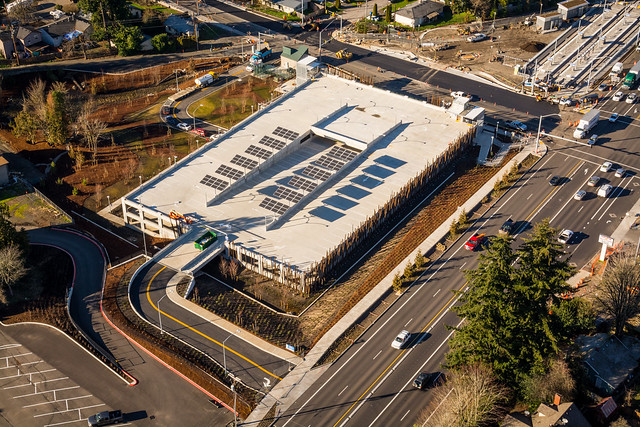
(Photo: TriMet)
Another possibility, suggested by the FTA in its March 6 letter to TriMet, is that the agency could use its remaining local funds to expand the free park-and-rides at the Tacoma or Park Avenue stations.
Some residents near those stations support that plan, saying it would prevent spillover into nearby neighborhoods.
“I would personally love to see a multi-story garage,” wrote Gail Hoffnagle, president of the Sellwood Moreland Improvement League, in a February email about the possibility of expanding the Tacoma station’s new 320-space parking lot into an 800-space garage. “We have several apartment buildings being constructed in Sellwood without parking and it is already making parking more difficult. I have been dreading the opening of the Orange Line because of the parking problems it will cause in the neighborhood.”
However, now that the FTA has rejected using federal transit matching funds to build those larger garages, it’s not clear whether TriMet can find $34 million in purely local funds for one or both. It’d be $17.5 million for the Tacoma garage, $7.7 million to add two more floors and 245 parking spaces to the Park Avenue garage. The purely local money is limited in part because a large share of the Orange Line savings come from lower financing costs, all of which had been part of the local match.
The final possibility for TriMet’s surplus is that it if it isn’t spent at all, the local share would be divvied up among its funding partners: among them the Oregon Department of Transportation, Metro, Clackamas County and the cities of Portland and Milwaukie.
In an email Tuesday, Fetsch’s language suggested that some amount of refund to other government agencies is almost certain.
“The refunds are expected to be fairly small because the cost of financing, which counts as local match, is running smaller than planned due to low interest rates,” she wrote. “There is no timeline for when a decision might be made. But when refunds do occur, each partner can choose to do with the money whatever they prefer.”
Correction 4 p.m.: A photo caption in an earlier version of this post gave the wrong name for the Eastside Greenway Trail and incorrectly described the $65 million already invested in biking and walking infrastructure. That sum includes the pathways on Tilikum Crossing.


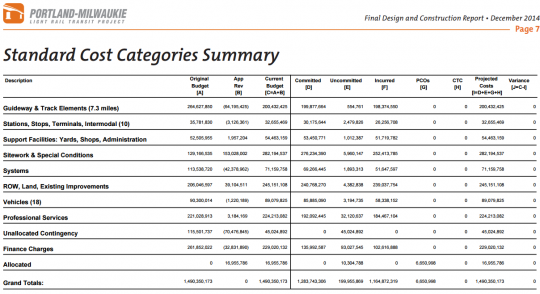
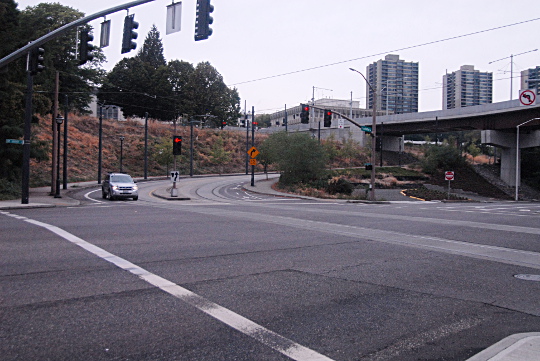
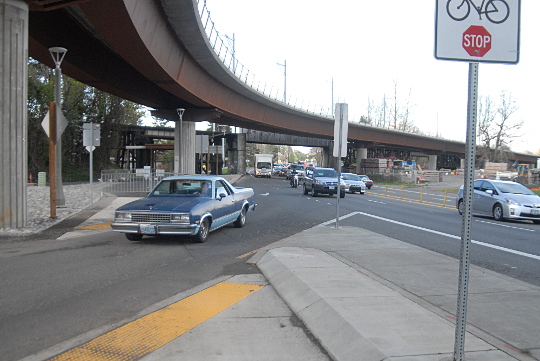
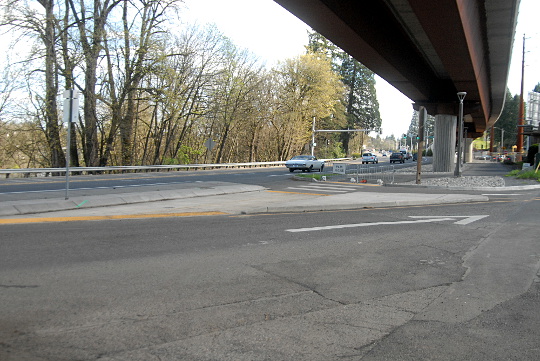

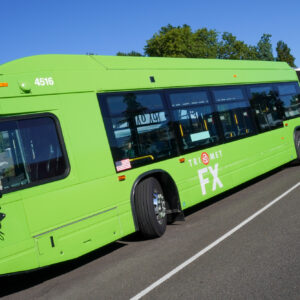

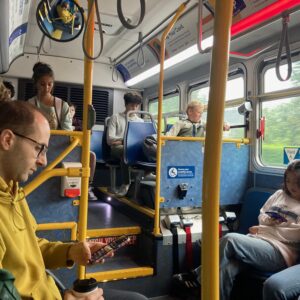
Thanks for reading.
BikePortland has served this community with independent community journalism since 2005. We rely on subscriptions from readers like you to survive. Your financial support is vital in keeping this valuable resource alive and well.
Please subscribe today to strengthen and expand our work.
One capital project that would be really beneficial would be to fix a really bad spot left over from the installation of the Yellow Line: the Larrabee overpass which causes a section which has lots of truck traffic along the Yellow Line to squeeze the bike lane down to 2’7″.
The latest version of the Comprehensive plan has a new plan with a 6-10 year window for a capital project to fix this problem and also remove a potential major headache if we experience an earthquake which could collapse the overpass onto the MAX tracks. In addition, despite the significant impact this would have in preventing future disruption in an earthquake, the estimated cost would be just $1 million.
All info on cost & project via Transportation tab: http://www.portlandmaps.com/bps/cpmapp2/
Echoing Blake – fix that spot, and also – how about completing the gap in the I-205 Bike path from the Green Line construction? Trimet built a new bridge over Johnson Creek, but failed to make it wide enough to include the bike/ped path and complete the gap over SE Flavel to the Flavel transit station. $34M is far in excess of what would be required to build a bridge for the path over Johnson Creek (and the attendant EIS), and add a crossing signal and safety improvements on Flavel.
How about also looking for other areas where bike/ped improvements are not up to spec? Again with the Yellow Line – how about the disappearing bike lanes between Killingsworth and Rosa Parks? How about the crossing of the I-205 bike path at NE Glisan, immediately adjacent to the Red Line – an undercrossing could be constructed. Why should it be free parking when the money could be spent on improvements for everyone who walks or bikes to/from a Trimet station?
Seriously about those disappearing bike lanes on Interstate Ave!!! I’ve always been… what the, where’s the lane go? There’s plenty of space for it to run the entire length!! 🙂
It’s always smarter to over budget because you can look ‘good when you come in under budget.
The $1.5 billion total project cost was absurd in the first place.
Nevertheless it does restore some confidence that $200 million is being returned.
Lets see how this plays out in the end.
Good story thanks
How about 24/7 secure bike parking facilities (not lockers) at these new stations? Or has First-Mile-Last-Mile capital improvements to rail stations fallen out of favour?
And why is any ‘urbane’ transit agency still giving away station area car parking for free? Even if the the capital costs are almost free from the feds there are 20 to 30 years of operations and maintenance and lost land rent (and other opportunity costs).
I think the parking garages are a worthy commitment. It’s tempting to decry parking, but saw the light when my “interested but concerned” at the time girlfriend got a job downtown and the Gateway garage just barely tipped the scales against driving all the way. Saved hundreds of person-hours in traffic. Charging for parking (or not providing it at all) would have tipped the scales the other way.
And the Feds only cover half, so that’s still about $10,000 PER SPOT to build garage parking.
How about a sidewalk + bike alne to the streetcar viaduct over the rr tracks connecting OMSI and MLK?
Max: Many of us have also been advocating for this, since before the streetcar project was approved. It is a critical element in the Eastside section of the Green Loop planned around the Central City. Currently the only way to get to the OMSI station from the are of Goodwill, is to go north clear to Clay, or south to where SE 8th crosses Division and the UPRR tracks. The SE Quadrant Plan makes a mention of it, but it’s a long way from funded. It might qualify for the PMLR funds, as a way to get to the OMSI LRT station. I don’t know if there are any cost estimates for it.
When the new line opens it’s possible the Yellow AND Orange will service the new Clinton station. There is going to be a LOT of foot/bike traffic where Clinton hits 12th since the old bridge was taken out at the skate park (Trimet expects over 22k weekday rides by 2030).
It would make a lot of sense to put a diverter at Clinton and 12th. Local drivers looking to get to Clinton can take Ivon home, and commuters can use Division.
5 grand out of 34 mil can turn that intersection into a really cool and safe place. I can see carts along Gideon or Clinton during the Summer.
Only the Orange line will be serving stops on the eastside. Now, most of those trains will change to yellow when the get downtown (with the exception of some rush hour trains). So the frequency is going to be pretty much the same as the yellow.
Actually, the yellow and orange line trains will be overlapping in downtown, so it doesn’t look like they will be changing color at this stop. They will not be interlining.
source: http://portlandtransport.com/archives/2013/04/trimet_confirms.html
That info is out of date.
Orange line trains heading north from Milwaukie will change to Yellow before they reach PSU. South bound Yellow line trains will change to Orange at some point (presumably before union station). Some northbound rush hour trains will stay as Orange line and instead turn around at union station.
This info is from the interview Portland Transport did with TriMet GM Neil McFarlane last year. Unfortunately, I’m on my phone, and can’t link very easily.
Given the budget pressures at the federal level, I wouldn’t be surprised if any ideas for spending this money get denied. The federal transportation fund is broke, and Congress isn’t going to do anything that will raise new revenue.
Put a bike valet at PSU!
Shouldn’t that be funded by PSU?
They could re-institute some of the improvements that were cut or not included in parts of Milwaukie. A few come to mind:
1. Pave the short section (50 feet?) of gravel at 28th Avenue leading from Ardenwald to the Springwater which will be heavily traveled by Milwaukie residents who will access the Tacoma Station.
2. Re-institute the stair way that went from the Springwater trail down to the Tacoma area station area.
3. More bike parking at the Milwaukie Main St Station, perhaps a secure cage. There is no auto parking at this station and I have a feeling that the bike parking provided in this area will quickly be filled after the light rail opens.
These are great ideas. Directly related to the project and small enough for short-time funding.
How about building a portion of the Green Loop between SW Moody and the Park Blocks? From Moody/Sheridan the preferred plan seems to be to go under I-405, along Water, up a rebuilt Carruthers, onto a new MUP parallel to 405, along 4th, and then up College to the Park Blocks. It would massively increase connectivity between PSU and South Waterfront for bikes and pedestrians, and would be close enough to the light rail alignment that it could be considered within scope.
Yes this would be ideal. Or for a fraction of the cost, simply put in a ramp from the existing stairs adjacent to the international school to the harbor structure at naito (about 2-300ft?).
Oh, and the column excuse for the Naito flyover is total bunk. They could have hung 10ft wide sidewalks off each side of the flyover. The ramps would start just north of Sheridan St. climbing up to the flyover just before the power substation, joining it to fly over Naito and join up with Lincoln. $5 -$10 million, tops.
Maybe some of that surplus could be used to implement Ted Buehler’s suggestion for making the railing along the bike lane a little less aggressive.
I second that. Those railings are dangerous, especially the double-spiked column tops. Not sure what they were thinking when they agreed to install those near a bike lane. They should be replaced PRONTO. Primum Non Nocere
Good God! The first thing that came to Trimet’s mind was tripling a parking garage? Yikes! Glad The Feds nixed that one and that everyone else’s ideas sound more useful.
So much for those ’42 cars stayed home because of this bus’ billboards.
There is also the 8 million multi-use-path and Tacoma bike parking commuter station that would connect the Springwater, Tacoma, Bybee and Holgate MAX stations. How about adding bike ramps to the Layfette Bridge overpass? The two million for phase one of the Holgate retrofit with bikelanes so people could actually GET to the Holgate MAX station east from 17th might be nice. Oh yes, there was that industrial old school 16th avenue overpass that was removed and not replaced…..there is a promise somewhere I heard.
LOBSTER FOR EVERYONE!
And beer!
While I appreciate the opportunity for biking infrastructure this savings represents, I imagine a portion of any refund from Tri-Met the City of Portland and Multnomah county receives would best be used to offset the projected cost overruns for the Sellwood bridge. In a perfect budget world it makes sense for the savings from one infrastructure project to offset the additional costs of another, similar project.
That was my thought. One project is going to finish under budget and early and the other is going to be over budget and really late.
Lesson learned: transit projects = on time and under budget, auto projects = late and over budget.
If you’re calling the Sellwood bridge ONLY an auto project then I don’t think you’ve seen the design (i.e. 4 lanes for bikes that will make it the best biking bridge in the city).
Tillicum will be the best biking bridge, as it won’t have speeding, poison-spewing car and truck traffic 2ft away from the riders.
And with the Sellwood, you must realize that the deck bike lanes exist to provide breakdown space/emergency vehicle access. They will never build a two lane bridge that is only 20-24ft wide. If a vehicle breaks down, it becomes a nightmare.
The majority of the traffic over the new Sellwood will be motorized, and the vast majority of the cost is due to motorize vehicle traffic. If a bike/pedestrian crossing was all they needed, they could have simply closed the old bridge to motor vehicles.
“Tillicum will be the best biking bridge, as it won’t have speeding, poison-spewing car and truck traffic 2ft away from the riders.”
So I take it you will want to take the “slow”, raised bike lanes on the new Sellwood?
And I wouldn’t exactly describe cinnamon and myrrh-spewing buses.
That mcloughlin overpass for the light rail has created a dark, depressing area.
Seriously. People used to picnic with their families on the shoulder of that 4-lane expressway!
How about restroring the Clinton Street pedestrian crossing over the UPRR tracks? The old one had to be demolished (its footings were in the right-of-way), and its replacement was cut from the project budget.
That would be nice. Freight trains often sit on the tracks there. They can take 15+ minutes to clear.
As Engineer Scotty and Terry D-M remember, the bridge from Gideon, across the UPRR tracks to the intersection of SE 16th and Brooklyn was removed, and not replaced because of PMLR budget cuts. If it turns out there is now surplus, adding back those things that were cut would seem the first thing to do. This should be a pedestrian and bike bridge across the light rail as well as UPRR tracks, which will connect not only with the “Clinton St. Station”, but with the multiuse path that proceeds north from there to the Tillicum Crossing, as well as the bike lanes south on 17th to McLoughlin.
Well, you CAN loop under the overpass from 17th/Powell bike path, head east along Powell, and come up on the east side of the tracks to access Clinton. On a bike, its actually pretty quick and a nice, wide new path.
I’m not sure what the benefit to bikes would be for another overpass at the same spot – it would have to be pretty long in order to be ADA compliant (2-3 blocks minimum?).
There does seem to be some space that could be used for a bridge landing near the new MAX station; there is a big gravel lot about 50 feet long x maybe 10-15 feet wide where a stairway and elevator could land to connect to the other side of the tracks.
While the Federal matching portions cannot be use for operations–if the Federal match is returned, might the local contributions be used for such? Or used to help retire/fund pension debt–freeing up other cash for ops?
TriMet’s bonds against its future payroll tax revenue can no longer be used for operations; the bond terms require them to be spent on capital only. I assume the same is true of the lottery bonds from the state, the single biggest local funding source.
Not sure about the other local sources from Portland, Clackamas, Metro, etc.
Can they be retired early? I’m assuming these bond proceeds aren’t limited to PMLR, but can be used for other capital improvements (if nothing else, as part of funding package/local match for Powell/Division)?
Yes, that’s right. Not sure if they can be retired early but I don’t see why not.
I wouldn’t be surprised if the outcome here were to give most of the excess back to the FTA, give some back to the other partners and squirrel away any remaining TriMet capital for Powell/Division. But that’s not necessarily incompatible with using drips and drops of FTA-matched funds to do some of the relatively small design changes discussed in this thread.
Build a replacement pedestrian train overpass at Brooklyn for the one they tore down. The underpass on Powell could use a gutter to keep muddy water from dripping down from the railroad for days after it stops raining. It’s gross, and I’ve seen poop on the ground for weeks. Also needs security cameras. Usually people living down there. Rarely feels safe at night. Some guy spit at me. The overpass because it didn’t have any shelter always felt safe by comparison.
Just think about how many bus stop seats and covers we could build! We could put in a bench and cover at every bus stop within the trimet system!
How about a Kicker or pay down the national debt?
How about world class bikeway connections to each of the stops along the new light rail line?
Clinton!
Center/9th!
Knapp/Ogden!
Monroe (Milwaukie)!
River/Park/Oatfield!
Fantastic Reporting!
Great question: “Could some of TriMet’s $34 million be spent to change this intersection from the highway exit it’s been into a normal urban right turn that would suit the lively commercial area the MAX line aims to create?”
I would like to see a flyover to PSU. I would imagine that the right of way is adequate adjacent to the max flyover.
Finish properly programming the new signals on the West end of the Tillicum Crossing would be a good start. Pedestrians who trigger the walk signal to cross Moody Ave. East will not only stop people in motor vehicles on Moody, they will also stop people on bikes going N. and S. on the separated cycle-track. Pedestrians don’t cross either bike lane to cross Moody so why are the signals forcing bikes to stop too? They shouldn’t be, and this issue was confirmed to me by a Tri-met worker I stopped and spoke with when I noticed the issue the other morning.
I’m afraid this will habituate people on bikes to blow the light thinking it’s just another pedestrian crossing…, setting up serious conflicts when it’s legitimately trains and buses signalling to come through.
As mentioned in the other thread —
Bring the Tilikum Bridge railings into compliance with the design standards in the Oregon Bicycle and Pedestrian Design Guide. This involves adding a 12″ tall “rub rail” at handlebar height so handlebars won’t get caught in the wires or snag on the vertical posts if a bicyclist brushes brushes against the rail.
See Figure7-9 and accompanying text above in: ftp://ftp.odot.state.or.us/techserv/roadway/web_drawings/HDM/Appendix_N_BikePedDesignGuide_Web.pdf
Everyone knows that the “next big Portland bike” innovation for 2020 will be the trébuchet de velo!…I am just waiting for NACTO to approve my drawings.
So they cut the observation areas from mid-span of the bridge unnecessarily? That’s too bad because people will be stopping there for the view anyway.
Lots of good ideas in this thread. Hopefully Trimet is reading this.
No, they are still there.
As others have mentioned, add a multiuse path alongside the MAX viaduct from Tillicum West up to SE Lincoln and Naito. This would make a quick, safe, hassle-free connection for bicycles and pedestrians from PSU to SE Portland.
It’s the orange route shown here:
https://www.flickr.com/photos/11599639@N03/15085317109/
Ted Buehler
West end connections……
If the money gets returned, I’ll be livid if one penny goes to Clackamas County after they voted against funding the Sellwood bridge.
How about traffic controls and a separated bike lane at the busiest bike intersection in downtown Portland – the Westend of the Hawthorne bridge as you merge onto Main and from the bike path/sidewalk? That stretch of road for four blocks is the one of the most congested in the city with Trucks and Buses frequently straddling two lanes because of the congestion and people who bike getting pushed right up against the curb as they go around the elk. Portland is supposed to be the bicycling capital of the US but the main bicycle entrances into downtown is one of the most dangerous stretches of road in the city.
That’s excellent that they will pay back a drop in the ocean of federal goobermint debt.
.
And this interview will give you a clue about how badly the goobermint will be needing that money in the near future. Note the pro-bicycle comment at about 13:10.
https://www.youtube.com/watch?v=MUeSjdt6_Bo
That pro-bicycle comment is actually a few seconds before 13:10.
I’d be happy to clear my schedule, and do odd jobs on the bridge for a cool million.
You could probably get a $1M grant to study something from that bridge – just have to think it up and put in the proposal to the right place. Just one example: As someone above noted the handrail posts are going to cause some nasty injuries to cyclists. Might be some kind of study related to that.
Put the “deferred” Harold Street station back into the project, complete with a pedestrian/bike viaduct at Reedway.
Put up solar panels up to offset the cost of running the trains. I don’t know how much you could get with $34M but maybe enough to “roof” a bike path?
FTA allows transit $$ to be used for 1/2 mile access to transit for walking trips. Make all transit stops safe to access to all through capitol improvements.
I’m very curious why there is no ‘official’ Trimet press release about this?
Seems like they would be bragging about this whole deal yet the only coverage of it is here.
I don’t get it…
A bit late to this thread, but I seem to recall that this project originally included a separate bike-ped path parallel to 99e, from 17th all the way down to Milwaukie; and that this path was cut due to budget constraints, and ODOT wanting to retain the right to widen that section of 99e in the future.
I would highly recommend building this path using the surplus budget. The highway does not need to be widened, now that there is a parallel light rail line. Because of the topography, a path in that location would be very good news for bicyclists seeking a low-slope way to access the new bridge! Plus, it would probably reduce the pressure to accommodate bicycles on the trains.